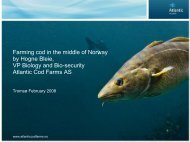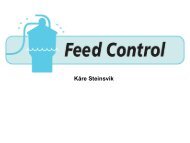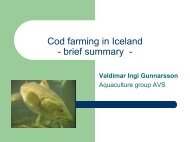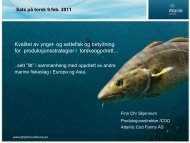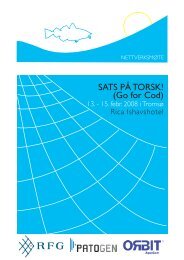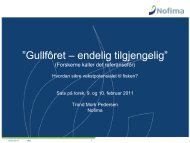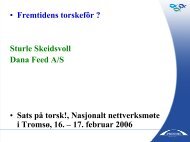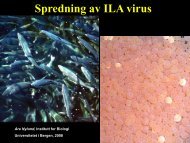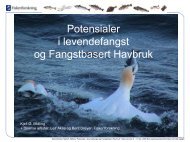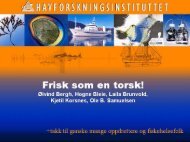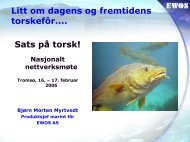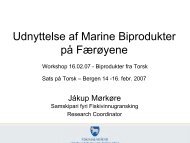You also want an ePaper? Increase the reach of your titles
YUMPU automatically turns print PDFs into web optimized ePapers that Google loves.
CLEANERFISH<br />
<strong>PRODUCTION</strong><br />
Espen Grøtan<br />
Marine Harvest Labrus AS
Use of cleanerfish<br />
• Cleanerfish is commonly used for biological delousing of<br />
salmon in Norway (increasing interest also in the United<br />
Kingdom and Ireland).<br />
• Different species of wrasse is added to the sea cages<br />
(typically between 2 and 5 %). Lumpfish can possible<br />
also be use for this purpose.<br />
• The method is proven efficient, environmentally friendly<br />
and economically beneficial.
Use of cleanerfish<br />
• Sharp upswing the last years as a result of the salmon<br />
industry's resistance problems.<br />
• More than 16 million wild wrasse was delivered to the<br />
salmon farming industry in 2010.<br />
• Reuse is not allowed (one does not know if the wrasse<br />
may act as a vector for transmission of salmon<br />
diseases).<br />
• Transfer of new diseases to salmon is considered not<br />
particularly likely (the species are far apart genetically).
Why farm cleanerfish?<br />
• Wild catch can`t meet the demand alone.<br />
• Development of good practices at salmon farms require<br />
predictability (the correct number of the right quality at<br />
the right time)<br />
• Available all year round (not depending on fishing<br />
season)<br />
• Size of cleanerfish can be adjusted to fit the mesh and<br />
salmon size<br />
• Can be vaccinated and screened for disease before put<br />
to sea<br />
• Avoid injuries and high mortality, which is common in<br />
wild capture<br />
• Reduce the risk of depletion of wild stocks
Production in Norway<br />
• Commercial wrasse production started only 2 years ago:<br />
- Marine Harvest Labrus (2009)<br />
- Profunda (2010)<br />
- Nordland Leppefisk (2010)<br />
- Cleanfish (2011)<br />
• Limited knowledge of the species in aquaculture and of<br />
the biology in general makes production very challenging
Marine Harvest Labrus AS<br />
• Started large scale production of Ballan wrasse in spring<br />
2009<br />
• Uses techniques from cod production with adjustments<br />
• User former cod facility close to Bergen (CCN), which is<br />
very well suited for this purpose<br />
• Aims to supply Marine Harvest Norway with all the<br />
wrasse they need (between 2 and 4 million pr. year)
Marine Harvest Labrus AS<br />
Juvenile production (0,5 gram)
Broodstock<br />
• Ballan wrasse are hermaphrodites (first female, then<br />
male)<br />
• Males are territorial<br />
• Aggression leads to bite injuries, often followed by<br />
infection and death<br />
• Need shelters in the tank<br />
• Soft feed (crushed pellets + shrimp)<br />
• About 20% males in the tanks
Egg collection / incutation<br />
• Benthic and sticky eggs<br />
• Spawning substrates (mats) are placed at the bottom of<br />
the tanks<br />
• Eggs are on incubated at 12 degrees for 7 to 9 days<br />
(attached to the substrates)<br />
• Diameter of eggs are 0.9 mm (salmon: 5.0)<br />
• 1000 000 - 1500 000 eggs per liter (salmon: 5000)
Spawning
Embryo inside the egg
Startfeeding<br />
• The larva is 3.6 mm at hatching<br />
• Very little developed<br />
• First feeding at 4 dph, when the mouth is opened and<br />
the yolk sac is almost gone<br />
• Live feed (rotifers) during the first 4 weeks<br />
• Clay is used for “green water” for about 50 days<br />
• The temperature is raised to 16 degrees
Newly hatched larvae
Weaning<br />
• After about a month the larvae is weaned on to dry feed<br />
• Critical period – if there has been suboptimal conditions<br />
during live feed period (high bacterial pressure, porly<br />
enriched rotaorier) the larvae will not withstand the<br />
transition to dryfeed and die<br />
• Changes the behavior after metamorphosis<br />
- clump together (anti-predator behavior?)<br />
- makes efficient feeding difficult
Larvea 30 dph
Juvenile 45 dph
On growing<br />
• Lice pickers needs to be between 30 and 70 grams (10 –<br />
14 cm)<br />
• In the first 4 cycles we experienced poor growth, high<br />
mortality and deformities after 0,5 grams due to lack of<br />
proper on growing feeds (all commersial feeds failed)<br />
• Better results in cycle nr. 5 when the period using larval<br />
feed was extended, and we started using a feed that has<br />
been developed specially for wrasse
Juveniles 90 dph
Juveniles 90 dph
Juveniles 90 dph
In the sea cages<br />
• Tests performed in tanks on land shows that farmed<br />
Ballan wrasse picks lice from salmon.<br />
• Still little experience from sea cages (first fish from MHL<br />
put to sea in june 2011):<br />
- will they eat lice or will they just go after the waste<br />
feed?<br />
- do they have the ability to pick lice as effective as wild<br />
specimens (vision, maneuverability)?
Main challenges<br />
• The use of spawning substrates provides poor utilization<br />
of the amount of spawned eggs and makes disinfection /<br />
incubation difficult (need methods for stripping?)<br />
• Problematic on growing phase (0,5 grams and up)<br />
- slow growth<br />
- need special feed<br />
- need high temperatures<br />
- clumping makes proper feeding difficult



